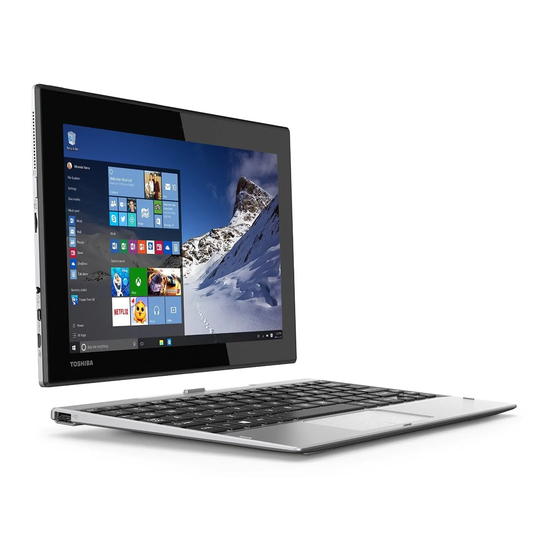
Table of Contents
Advertisement
Quick Links
User's Manual
Satellite Click LX0W-C/Satellite
Click LX5W-C/Satellite Click10
LX0W-C/ Satellite Click10 LX5W-C
Encore LX0-C/Encore LX5-C/Encore 10
LX0-C/Encore 10 LX5-C LX0W-C/
LX5W-C/LX0-C/LX5-C
dynabook N40
dynabook NB40
dynabook S60
N40
NB40
S60
Encore 10K LX0W-C
Encore 10K LX5W-C
Satellite Click 10/Encore 10 series
(Docking only)
Keyboard Dock PA5240*-****
(Docking only)
キーボードドック PA5240*-****(Docking only)
Advertisement
Table of Contents

Summarization of Contents
TOSHIBA Legal, Regulatory, and Safety
Copyright, Disclaimer, and Trademarks
Details intellectual property rights, disclaimers, and trademark acknowledgments.
Regulatory Information
Covers CE compliance, EU directives, and product safety standards.
Video Standard Notice
Licensing information for video technologies like AVC, VC-1, and MPEG-4.
OpenSSL Toolkit License Issues
Explains the licensing terms for the OpenSSL toolkit used in the software.
FreeType License Issues
Outlines the licensing terms for the FreeType font engine software.
ENERGY STAR® Program
Information on energy efficiency and power management for compliance.
Disposing of the Computer and Battery
Instructions for proper disposal and recycling of the computer and battery.
General Precautions
Safety guidelines for handling, ventilation, environment, and stress injury prevention.
Safety Icons
Explains the meaning and usage of safety warning icons found in the manual.
Getting Started
Equipment Checklist
Lists all included hardware and documentation components.
Dual Operating Mode
Explains the computer's dual functionality as a tablet and laptop.
Conventions
Describes manual formatting and symbols for clarity.
Using Your Computer for the First Time
Step-by-step guide for initial setup, connecting peripherals, and powering on.
Getting to Know Windows
Introduces basic Windows OS features like Start screen and Charms.
Turning Off the Power
Details procedures for shutting down, sleeping, or hibernating the computer.
The Grand Tour
The Computer (Tablet Mode)
Identifies essential components and features in tablet configuration.
The Computer (Laptop Mode)
Details computer layout and components when used with keyboard dock.
TOSHIBA Keyboard Dock
Explains features and connection points of the optional keyboard dock.
Internal Hardware Components
Describes internal parts like battery, CPU, and memory.
Operating Basics
Operating in Tablet Mode
Provides instructions and precautions for using the computer in tablet form.
Changing Screen Orientation
Explains automatic screen orientation adjustment and control.
Calibrating Digital Compass
Guides users on calibrating the compass sensor for accurate readings.
Using the Touch Screen
Details gestures and interactions for operating via touch screen.
Using the Touch Pad
Explains gestures and functions for navigating with the touch pad.
The Keyboard
Describes keyboard layout, function keys, and special keys.
3D Playback on an External 3D Device
Information on setting up and using the computer for 3D video output.
Battery
Explains battery usage, charging, care, and monitoring for optimal performance.
Memory Media
Details usage, formatting, and care of memory cards like microSD.
External Display
Instructions for connecting and configuring external monitors via HDMI.
Sound System and Video Mode
Guides on adjusting volume, microphone levels, and video playback.
Utilities and Advanced Usage
Utilities and Applications
Overview of pre-installed software tools for computer management.
Special Features
Highlights unique or advanced TOSHIBA computer functionalities.
TruCapture
Details camera application for improved whiteboard and document photography.
TOSHIBA Setup Utility
Guide to accessing and using the BIOS setup utility for system configuration.
System Recovery
Instructions for creating recovery media and restoring the system.
Troubleshooting
Problem-Solving Process
Guidelines and steps for diagnosing and resolving computer issues.
Preliminary Checklist
Basic checks for common hardware and connection issues before troubleshooting.
Analyzing the Problem
Steps to identify root cause by observing system behavior and error messages.
Hardware and System Checklist
Lists common hardware components and peripherals that may cause problems.
TOSHIBA Support
Information on how and when to contact TOSHIBA for technical assistance.
Appendix
Specifications
Summarizes technical specifications including physical dimensions and environmental requirements.
AC Power Cord and Connectors
Details specifications and certifications for power cords and plugs.
Information for Wireless Devices
Covers wireless technology interoperability, health impacts, and compliance.
Legal Footnotes
Provides explanations for icons, CPU performance, and legal notices.
Glossary
Defines technical terms and abbreviations used throughout the manual.













Need help?
Do you have a question about the Gigabeat S60 and is the answer not in the manual?
Questions and answers